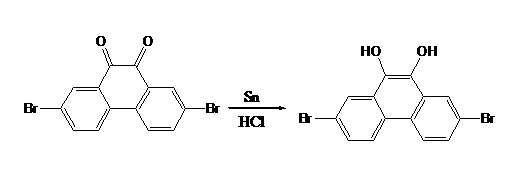2,7-dibromide-9,10 substituted-phenanthrene derivatives
A derivative, 10- technology, applied in the field of 2, phenanthrene derivatives and their preparation, can solve the problems of large solvent consumption and poor solubility, and achieve the effects of improved solubility, easy purification, and improved blue luminescence performance
- Summary
- Abstract
- Description
- Claims
- Application Information
AI Technical Summary
Problems solved by technology
Method used
Image
Examples
example 1
[0019] Example 1: Synthesis of 2,7-dibromo-9,10-diethoxyphenanthrene
[0020] (1) 2,7-Dibromophenanthrenequinone
[0021]
[0022] Under full stirring, 17.95 g of NBS was added to 98% concentrated sulfuric acid containing 10 g of 9,10-diphenanthrenequinone by mass, and stirred at room temperature for 3 h, then the mixture was poured onto ice cubes, the organic matter was filtered, and washed with cold water. The crude product was recrystallized with DMSO to obtain 13 g orange-red 2,7-dibromophenanthrenequinone, yield: 75%.
[0023] 1 H NMR (300 MHz, DMSO), δ / ppm: 8.30-8.21 (2H), 8.13-8.04 (2H), 8.03-7.81 (2H).
[0024] Ms ( m / z ): 366 (M + )
[0025] (2) 2,7-dibromo-9,10-dihydroxyphenanthrene
[0026]
[0027] Under reflux, add 10 mL concentrated hydrochloric acid in batches to 50 mL glacial acetic acid solution containing 3.66 g 2,7-dibromophenanthrenequinone and 4 g Sn, continue reflux for 1 h, distill most of the glacial acetic acid, and pour the rest Pour into...
example 2
[0035] Example 2: Synthesis of 2,7-dibromo-9,10-dipropoxyphenanthrene
[0036]
[0037] Add 2,7-dibromo9,10-dihydroxyphenanthrene (2.0 g, 5.4 mmol) and a catalytic amount of trifluoromethanesulfonic acid in 20 mL of propanol as a solvent, heat to reflux for 2 h, distill off part of the solvent and concentrate the reaction mixture. It was then washed with water and recrystallized from methanol to obtain 1.9 g of gray solid, M.P., 124.9 °C (by DSC), with a purity greater than 95 % and a yield of 78 %.
[0038] 1 H NMR (400 MHz, CDCl 3 ), δ / ppm: 8.43-8.40 (m, 2H ), 7.71-7.64 (m, 4H ), 3.37–3.57 (m, 4H), 1.60–1.55 (m, 4H), 0.87 (t, 6H, J= 7.36 Hz). 13CNMR (CDCl 3 , 400MHz, ppm) δ 143.0, 131.6, 130.5, 125.9, 124.6, 122.6, 120.9, 77.1, 22.6, 10.4.
[0039] Ms(m / z): 453 (M + ).
example 3
[0040] Example 3: Solubility Experiment
[0041] Comparing the solubility of 2,7-dibromo-9-phenanthrene derivatives in patent 201210287739.6 with that of 2,7-dibromo-9,10-phenanthrene derivatives in this patent, the results are as follows:
[0042] compound Solubility(g / mL) 2,7-Dibromo-9-hydroxy-10-p-tolylphenanthrene 0.7 Synthesis of 2,7-dibromo-9-hydroxy-10-phenylphenanthrene 0.4 2,7-Dibromo-9-hydroxy-10-p-xylphenanthrene 0.8 Synthesis of 2,7-dibromo-9-hydroxy-10-p-biphenylphenanthrene 0.2 2,7-Dibromo-9,10-diethoxyphenanthrene 2 2,7-Dibromo-9,10-dipropoxyphenanthrene 3
PUM
 Login to View More
Login to View More Abstract
Description
Claims
Application Information
 Login to View More
Login to View More - R&D
- Intellectual Property
- Life Sciences
- Materials
- Tech Scout
- Unparalleled Data Quality
- Higher Quality Content
- 60% Fewer Hallucinations
Browse by: Latest US Patents, China's latest patents, Technical Efficacy Thesaurus, Application Domain, Technology Topic, Popular Technical Reports.
© 2025 PatSnap. All rights reserved.Legal|Privacy policy|Modern Slavery Act Transparency Statement|Sitemap|About US| Contact US: help@patsnap.com



